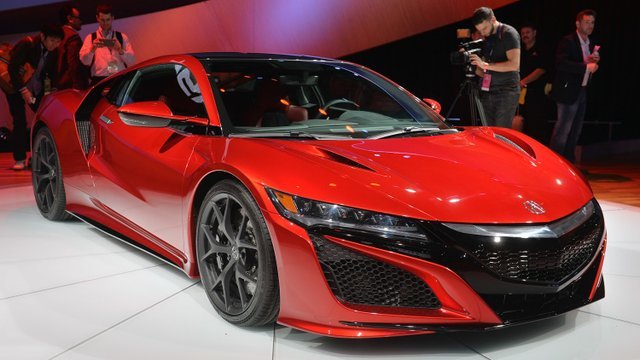Performance Cars Overpower the Detroit Auto Show

It was the second coming of Acura's iconic sports car, and the reveal had all of the expected trappings. Afterwards, champagne corks popped and the bubbly flowed. It was noon in Detroit, but for the green-car movement, it seemed like the clock had struck midnight.
That's an exaggeration, but performance was the overwhelming theme of North America's most important show. Ford – which has helped lead the way in smaller displacement engines and early adoption of hybrid powertrains – had more than 1,500 horsepower on stage one point after it revealed the GT concept, the new F-150 Raptor and the Shelby Mustang GT350R. The NSX is technically a hybrid (it has three electric motors), but with 550-plus hp, there's no doubt this Acura was bred on the track.
The theme continued throughout the show at nearly every stand. Alfa Romeo showed off the 4C Spider, which is the open-air version of a car that purports to be the spiritual successor of the high-performance 33 Stradale from 1967. On Tuesday, Cadillac is scheduled to reveal the 640-hp CTS-V with the V8 transplanted from the Corvette Z06, and the Lexus was expected to roll out its own V8-powered beast, the 467-hp GS F.
For enthusiasts – especially enthusiasts with money – these are halcyon days. But make no mistake, all of this power has a purpose. Ford product chief Raj Nair said the Blue Oval uses high performance cars to develop technologies, like aerodynamics and materials, which are then shared across its lineup.
"It's another proof point about how serious we are in developing innovation through performance," he said.
Ford, which is rolling out at least 12 performance cars by 2020, said the sporty cars attract younger and more influential buyers to its fold, which can help burnish its image beyond adding sales volume.
Toyota is taking a similar approach, senior vice president Bob Carter said, noting the Lexus RC coupe draws people into showrooms and gets them excited about the brand, even if they don't end up buying one.
"They provide an aspiration and a halo that provides the attention that gets you noticed in a cluttered market," he said.
Other Trends
Not every automaker showed a sports car in Detroit – it only felt that way – but there were other trends from the show that carried wide-ranging implications for the industry.
Automakers aren't betting on low gas prices. In fact, BMW board member Ian Robertson said his company "should not be distracted" by them, as he doubts they're a permanent thing. "No one can tell me it's not going to go in another direction," he added.
That sentiment was clearly evident at the Chevy stand, where the next generation Volt debuted, accompanied by an all-electric concept car, called the Bolt. Billed by General Motors CEO Mary Barra as "an EV for everyone," the Bolt will offer a 200-mile range on all-electric power for a price tag of about $30,000. Seen an answer to Tesla and its potential future products, the Bolt also will have advanced materials like magnesium, aluminum and carbon fiber.
The SUV still matters. The industry experienced growth in 2014 on the strength of strong sport utility vehicle sales, as showcased by brands like Jeep. An IHS analysis of retail registrations last year showed crossovers and SUVs passed sedans as the most popular body style in the United States, bumping four-doors from their long-held position at the top. While not as conspicuous as the sports car reveals, SUVs were just as common at the Detroit show. Volkswagen debuted a five-seat midsize SUV concept, called the Cross Coupe GTE, which previewed the seven-seater it plans to build in Chattanooga, TN.
Meanwhile, Mercedes showed its answer to the BMW X6, the GLE coupe, including the 577-hp AMG variant, and Volvo revealed the S60 Cross Country, which gives the S60 sedan the ride height and demeanor of a crossover. Audi also debuted an updated Q7, which will also have a plug-in hybrid E-Tron version.
As Volkswagen of America CEO Michael Horn put it: "People in America want space."
Trucks still matter, too. Two old warhorses – the Nissan Titan and the Toyota Tacoma – finally received updates. Hyundai did a concept pickup that it pitched as a "crossover truck," and the Ford F-150 Raptor generated plenty of buzz, even as it competed with the GT supercar concept for attention.
Market confidence is soaring. People are buying cars. Industry executives were resoundingly bullish in their outlook after 2014 sales flirted with 17 million. Economic indicators appear strong on a variety of fronts, with unemployment levels dropping and the gross domestic product increasing.
"We're seeing a lot of positive signs that are continuing," said Scott Keogh, president of Audi of America.
Related News


